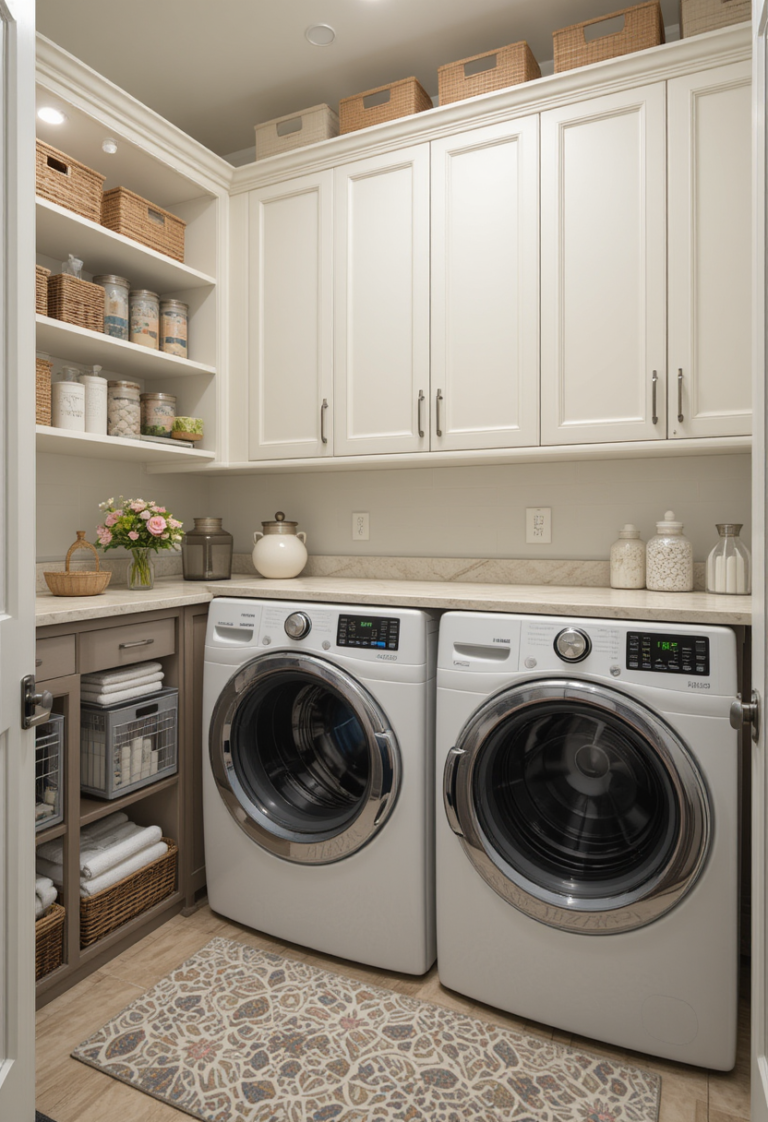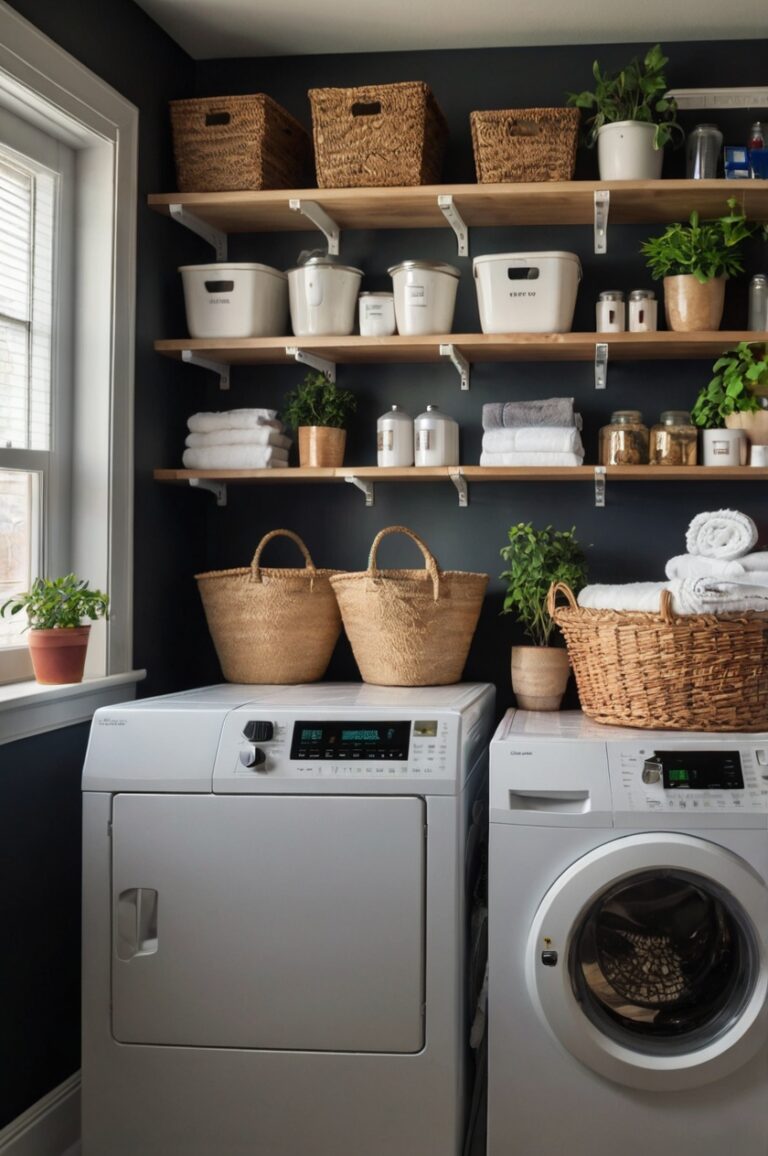Does your living room feel off-kilter, like something’s missing or out of place? It’s a layout issue many people deal with. An unbalanced living room layout is one of the most common decorating challenges homeowners face, especially when dealing with awkward room shapes, unusual architectural features, or furniture that doesn’t quite fit the space as expected.
The good news? You don’t need a complete remodel to transform your space into a harmonious, well-proportioned room. These ten strategic fixes will help you create visual balance and flow using what you already have, plus a few smart additions that won’t break the bank.
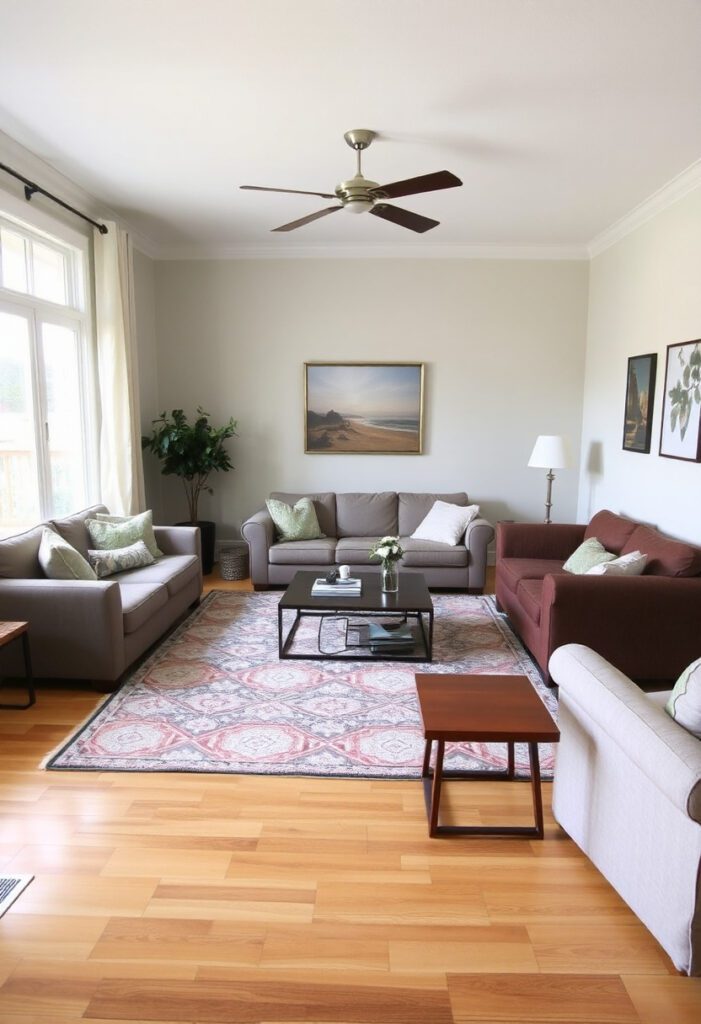
Understanding What Makes a Living Room Feel Unbalanced
Before diving into solutions, it’s essential to identify the root cause of your space’s imbalance. Common culprits include furniture pushed against one wall, inadequate lighting distribution, or a lack of visual weight on one side of the room. An unbalanced living room layout often stems from poor furniture placement rather than the furniture itself.
1. Redistribute Visual Weight with Strategic Furniture Placement
The fastest way to fix an unbalanced living room is to redistribute visual weight across the entire space. Heavy, dark furniture pieces naturally draw the eye and create visual anchors. If all your substantial pieces are clustered on one side, the room will feel lopsided.
Move your heaviest piece away from the wall and position it to create better balance. For example, if your sofa dominates one corner, try angling it toward the center or moving it to face the room’s focal point. This simple furniture layout tip for awkward living rooms can instantly improve the space’s flow.
2. Create Symmetry with Matching Pairs
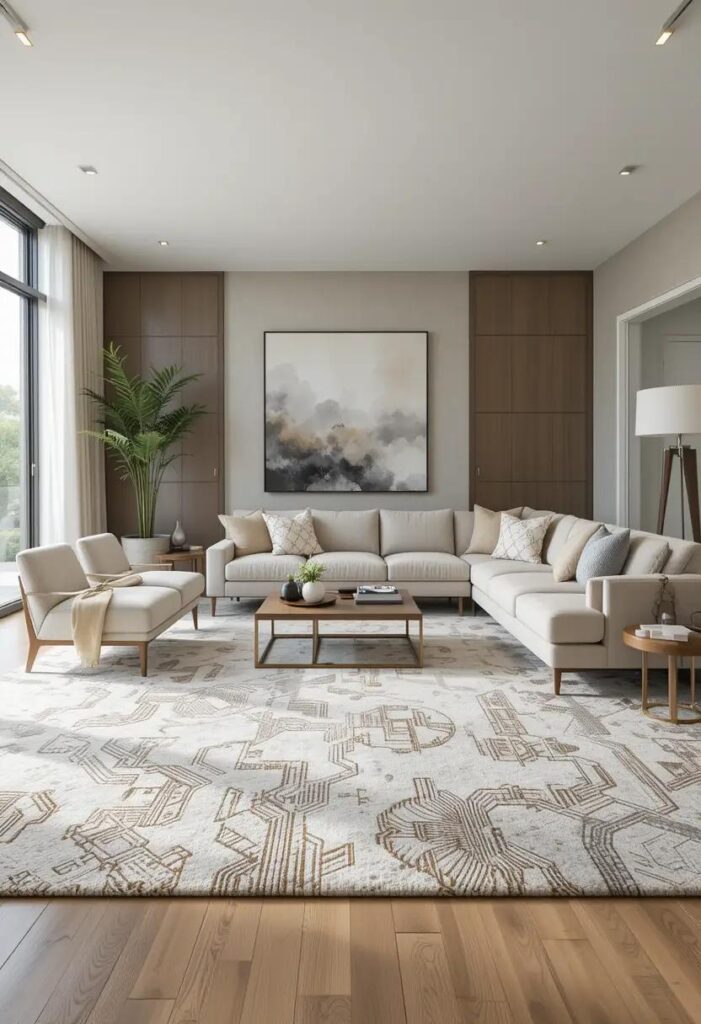
Symmetry is your secret weapon for decorating an unbalanced living room. Matching pairs of elements create instant visual balance without requiring major changes. Consider adding:
- Two identical table lamps on opposite sides of the room
- Matching accent chairs flanking a window or fireplace
- Paired side tables of similar height and style
- Two identical plants or planters in corresponding locations
This approach works particularly well for asymmetrical living room layouts where architectural features make perfect symmetry impossible.
3. Use Lighting to Balance Dark Corners
Poor lighting distribution is a major contributor to visual imbalance. Dark corners make rooms feel weighted toward the brighter areas, creating an uncomfortable visual pull.
Add floor lamps, table lamps, or even string lights to illuminate neglected corners. The key is creating multiple light sources at different heights throughout the room. This technique is one of the most effective quick living room decor fixes because it’s affordable and makes an immediate impact.
4. Anchor Empty Spaces with Statement Pieces
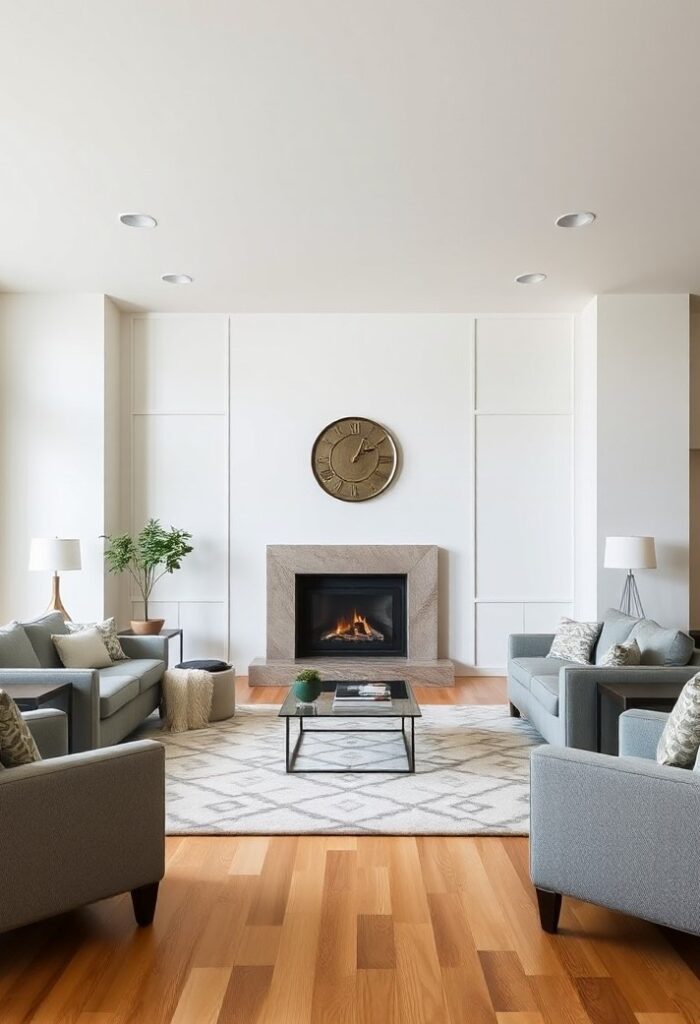
Large, empty areas can make a room feel unfinished and contribute to imbalance. Fill these spaces with statement pieces that match the visual weight of your existing furniture such as:
- A tall bookshelf or room divider
- A large floor mirror to reflect light and create depth
- A substantial plant like a fiddle leaf fig or monstera
These additions help distribute visual interest more evenly throughout the space.
5. Balance Colors and Patterns Strategically
Color distribution plays a crucial role in visual balance. If all your colorful elements are concentrated in one area, the room will feel weighted toward that side. Spread colors throughout the space by:
- Adding throw pillows in coordinating colors to different seating areas
- Incorporating a colorful rug on the lighter side of the room
- Using consistent accent colors in various accessories across the space
- Balancing bold patterns with solid colors to prevent visual overwhelm
For gray living room ideas, see 18 Elegant Gray Living Room Ideas for a Cozy and Sophisticated Look.
6. How to Fix an Unbalanced Living Room with Vertical Elements
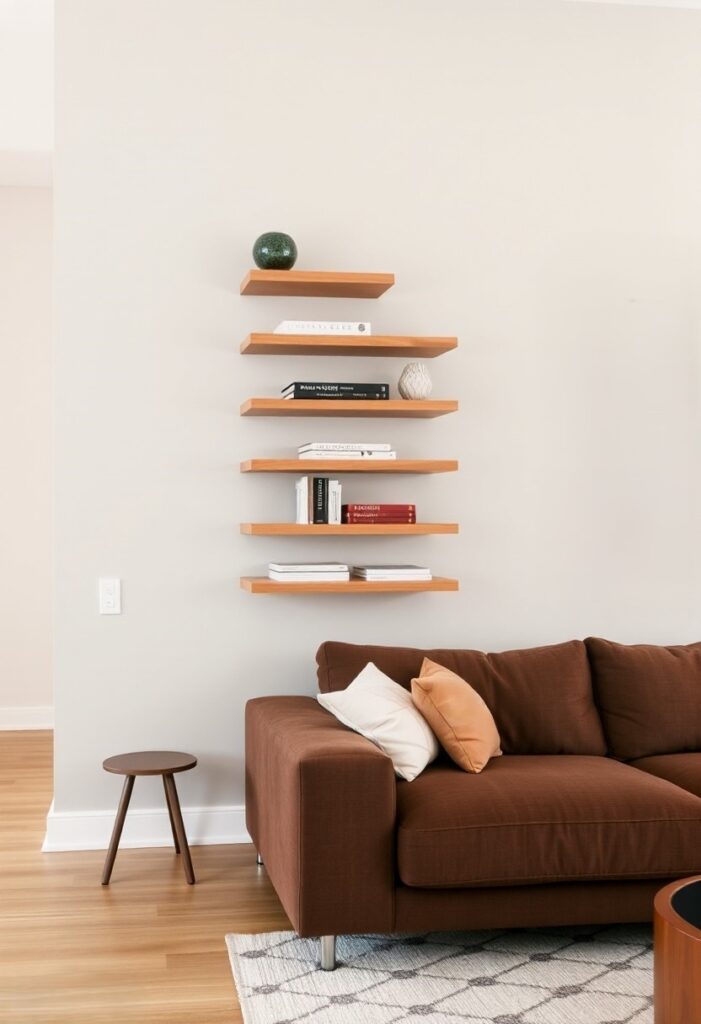
Vertical elements draw the eye upward and can balance horizontal-heavy layouts. If your furniture is all low and wide, add height with:
- Tall floor lamps or torchiere lighting
- Vertical wall decor like tall mirrors or stretched canvas pieces
- Tall plants or decorative branches in floor vases
- Floating shelves installed at different heights
This technique is particularly effective for lopsided living room layout ideas where one side feels too heavy or dominant.
7. Create Conversation Areas to Improve Flow
Sometimes imbalance stems from poor traffic flow or undefined spaces. Creating distinct conversation areas helps organize the room and distribute furniture more effectively. Try:
- Positioning chairs to face each other with a small side table between them
- Creating a reading nook in an unused corner with a comfortable chair and lamp
- Using a console table behind the sofa to define the seating area
- Arranging furniture in a U-shape or L-shape to encourage conversation
For more living room ideas, see 17 Living Room Summer Decor Ideas for a Light and Airy Space.
8. Use Rugs to Define and Balance Spaces
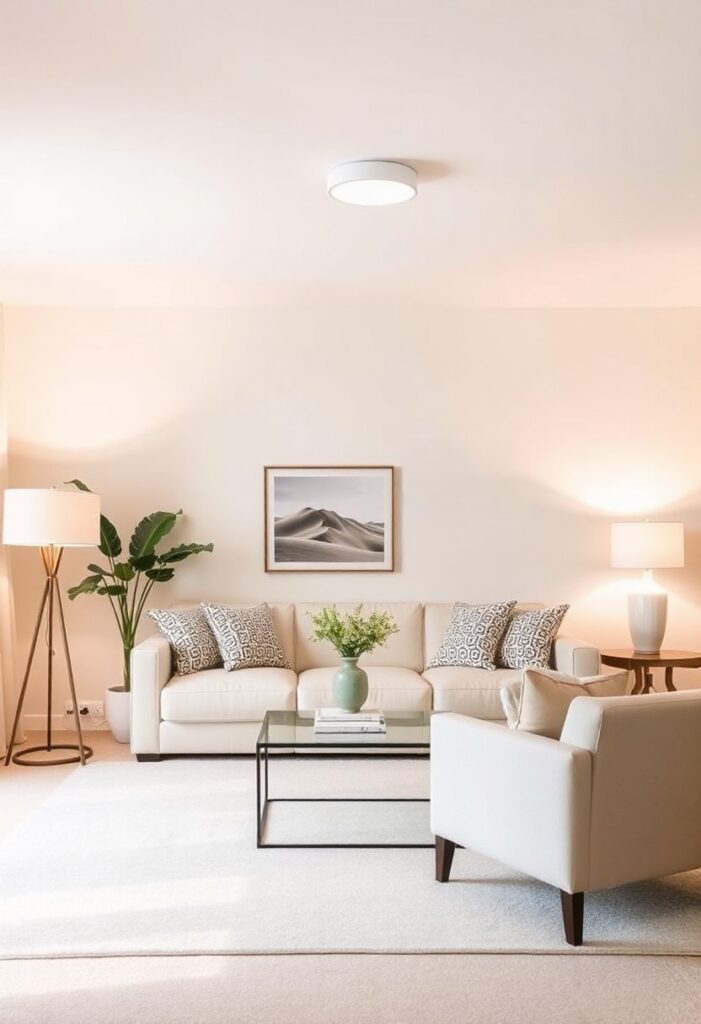
Area rugs are powerful tools for creating visual balance and defining spaces. A well-placed rug can anchor furniture groupings and make scattered pieces feel connected. For maximum impact:
- Choose rugs large enough for all furniture legs to sit on or just the front legs
- Use multiple smaller rugs to create distinct areas within a large room
- Select rugs with patterns or colors that complement your existing decor
- Layer rugs for added texture and visual interest
9. Add Functional Storage to Balance and Organize
Storage solutions can double as decorative elements while addressing balance issues. Strategic storage additions create visual anchors while improving functionality. Consider:
- A storage ottoman that serves as extra seating and surface space
- Built-in or freestanding shelving units to display books and decor
- A media console that provides storage while anchoring the television area
- Decorative baskets or boxes that add texture while hiding clutter
10. Mirror Placement for Enhanced Balance and Light
Mirrors are among the most versatile tools for correcting visual imbalance. Strategically placed mirrors can reflect light, create the illusion of more space, and balance heavy furniture pieces. Position mirrors to:
- Reflect natural light into darker areas of the room
- Create the illusion of depth in narrow spaces
- Balance a heavy furniture grouping on the opposite wall
- Enhance architectural features like windows or doorways
Common Mistakes to Avoid When Fixing Your Unbalanced Living Room Layout
While implementing these fixes, avoid these common pitfalls:
- Don’t overcrowd the space with too many balancing elements
- Avoid placing all furniture against the walls, which creates a bowling alley effect
- Don’t ignore scale – ensure new additions are proportionate to existing pieces
- Resist the urge to buy everything at once – implement changes gradually to see what works
Conclusion
Transforming an unbalanced living room layout doesn’t require expensive renovations or starting from scratch. These ten strategic fixes can dramatically improve your space’s visual harmony using simple rearrangements and thoughtful additions. Start with one or two techniques that address your room’s specific challenges, then gradually implement additional changes as needed.
Remember, the goal isn’t perfect symmetry but rather creating a space that feels comfortable, functional, and visually pleasing. With patience and experimentation, you can achieve the balanced, welcoming living room you’ve always wanted.
Frequently Asked Questions
How do I know if my living room layout is unbalanced?
Signs of an unbalanced living room include feeling drawn to one side of the room, having all furniture clustered in one area, noticeable dark corners, or a general sense that something feels “off” about the space. Stand in your doorway and notice where your eye goes first – if it’s always the same spot, you likely have a balance issue.
Can I fix an unbalanced living room without buying new furniture?
Absolutely! Many balance issues can be resolved by simply rearranging existing furniture, moving lamps to different locations, or redistributing accessories throughout the space. The key is creating visual weight distribution using what you already own.
What’s the biggest mistake people make when trying to balance their living room?
The most common mistake is pushing all furniture against the walls, thinking it will make the room feel larger. This actually creates an unbalanced, uncomfortable space. Instead, float furniture away from walls and create intimate conversation areas.
How important is lighting in creating a balanced living room?
Lighting is crucial for visual balance. Uneven lighting creates dark, heavy areas that throw off the room’s equilibrium. Aim for at least three different light sources at varying heights throughout the space to create even illumination.
Should I use symmetrical or asymmetrical balance in my living room?
Both can work depending on your space and style preference. Symmetrical balance is easier to achieve and feels more formal, while asymmetrical balance is more dynamic but requires careful attention to visual weight distribution. Choose based on your room’s architecture and personal taste.
How do I balance a living room with an awkward shape?
For oddly shaped rooms, focus on creating multiple functional zones rather than trying to center everything. Use furniture placement, rugs, and lighting to define different areas within the space, which helps minimize the awkward shape’s impact on the overall balance.
What role do colors play in living room balance?
Colors have visual weight – dark colors feel heavier while light colors feel lighter. Distribute colors evenly throughout the room to avoid having all the visual weight concentrated in one area. Use the 60-30-10 color rule: 60% dominant color, 30% secondary color, and 10% accent color spread throughout the space.

